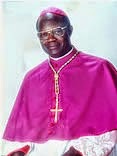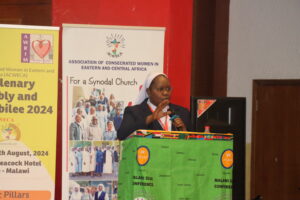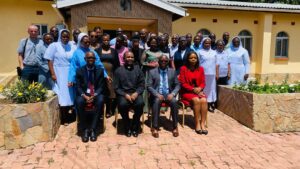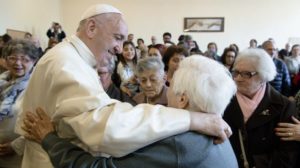AMECEA: A Journey with Archbishop James Odongo: Celebrating Our Living AMECEA History

A
reflection of Fr Joseph G. Healey, MM as Archbishop James Odongo celebrates the
Episcopal
reflection of Fr Joseph G. Healey, MM as Archbishop James Odongo celebrates the
Episcopal
 |
| Fr Joseph Healey |
Golden Jubilee on 21 February 2015 at Uganda Martyrs Cathedral,
Tororo, Uganda. Fr Healey writes “I was privileged to be the first Social
Communications Secretary of AMECEA from 1968-1974 based in Nairobi, Kenya.
Later Bishop Vincent McCauley, CSC, the Secretary General of AMECEA, called me
“one of AMECEA’s roving ambassadors.” I worked closely with Archbishop Odongo
when he was chairman of AMECEA between 1973 and 1979
Tororo, Uganda. Fr Healey writes “I was privileged to be the first Social
Communications Secretary of AMECEA from 1968-1974 based in Nairobi, Kenya.
Later Bishop Vincent McCauley, CSC, the Secretary General of AMECEA, called me
“one of AMECEA’s roving ambassadors.” I worked closely with Archbishop Odongo
when he was chairman of AMECEA between 1973 and 1979
1. SECOND
VATICAN COUNCIL (1962-65)
VATICAN COUNCIL (1962-65)
 |
| Archbishop James Odongo |
The
then Bishop James Odongo was consecrated (now the word is “ordained”) a bishop
on 16 February. 1965. Thus he went to the Fourth and Last Session of the Second
Vatican Council that took place in the Vatican (Rome) from 14 September to 8
December 1965. Presently there are three living bishops in the AMECEA Region
who officially participated in Vatican II – a significant historical milestone:
Archbishop Odongo, Retired English Bishop Colin Davies, MHM, of Ngong Diocese,
Kenya now living in England and Retired Tanzanian Bishop Gervas Placidus
Nkalanga, OSB of Bukoba Diocese, Tanzania now living at Hanga Abbey, Tanzania.
then Bishop James Odongo was consecrated (now the word is “ordained”) a bishop
on 16 February. 1965. Thus he went to the Fourth and Last Session of the Second
Vatican Council that took place in the Vatican (Rome) from 14 September to 8
December 1965. Presently there are three living bishops in the AMECEA Region
who officially participated in Vatican II – a significant historical milestone:
Archbishop Odongo, Retired English Bishop Colin Davies, MHM, of Ngong Diocese,
Kenya now living in England and Retired Tanzanian Bishop Gervas Placidus
Nkalanga, OSB of Bukoba Diocese, Tanzania now living at Hanga Abbey, Tanzania.
The fourth
and last session of the Second Vatican Council approved a total of eleven
documents of the 16 official documents including the especially important:
and last session of the Second Vatican Council approved a total of eleven
documents of the 16 official documents including the especially important:
®
Pastoral
Constitution on the Church in the Modern World (Gaudium et Spes)
Pastoral
Constitution on the Church in the Modern World (Gaudium et Spes)
®
Dogmatic
Constitution on Divine Revelation (Dei Verbum)
Dogmatic
Constitution on Divine Revelation (Dei Verbum)
®
Dogmatic
Constitution on the Church (Lumen Gentium)
Dogmatic
Constitution on the Church (Lumen Gentium)
®
Decree
on the Missionary Activity of the Church (Ad Gentes)
Decree
on the Missionary Activity of the Church (Ad Gentes)
®
In a
recent conversation Archbishop Odongo emphasized that all the bishops signed
these documents in the spirit of collegiality and joint ownership. All their
signatures are officially in the Vatican Archives. This also made the bishops
like him responsible to implement the teaching of the documents when they
returned to their home countries and dioceses.
In a
recent conversation Archbishop Odongo emphasized that all the bishops signed
these documents in the spirit of collegiality and joint ownership. All their
signatures are officially in the Vatican Archives. This also made the bishops
like him responsible to implement the teaching of the documents when they
returned to their home countries and dioceses.
2. AMECEA
(1973-1979): Some significant events during his leadership
(1973-1979): Some significant events during his leadership
1973: The AMECEA Study Conference on “Planning for the Church in
Eastern Africa in the 1980s” in Nairobi, Kenya in December, 1973 stated: “We
have to insist on building church life and work on Basic Christian Communities
in both rural and urban areas. Church life must be based on the communities in
which everyday life and work take place: those basic and manageable social
groups whose members can experience real inter-personal relationships and feel
a sense of communal belonging, both in living and working.” This pastoral
policy was in the context of the statement: “We are convinced that in these
countries of Eastern Africa it is time for the Church to become truly local
that is, self-ministering, self-propagating and self-supporting.”
Eastern Africa in the 1980s” in Nairobi, Kenya in December, 1973 stated: “We
have to insist on building church life and work on Basic Christian Communities
in both rural and urban areas. Church life must be based on the communities in
which everyday life and work take place: those basic and manageable social
groups whose members can experience real inter-personal relationships and feel
a sense of communal belonging, both in living and working.” This pastoral
policy was in the context of the statement: “We are convinced that in these
countries of Eastern Africa it is time for the Church to become truly local
that is, self-ministering, self-propagating and self-supporting.”
1974-75: Under the direction of Bishop Vincent
McCauley the new AMECEA Residence and Office Block was built on Gitanga Road in
Nairobi.
McCauley the new AMECEA Residence and Office Block was built on Gitanga Road in
Nairobi.
1975: The one year AMECEA Accountancy Course was established in
Nyegezi Social Training Institute (NSTI), now St. Augustine University of
Tanzania (SAUT) in Mwanza, Tanzania.
Nyegezi Social Training Institute (NSTI), now St. Augustine University of
Tanzania (SAUT) in Mwanza, Tanzania.
1976: The Apostolate to
the Nomads of AMECEA (ANA) was established.
the Nomads of AMECEA (ANA) was established.
The
AMECEA Pastoral Institute (API/Gaba) moved from Gaba, Kampala, Uganda to
Eldoret, Kenya due to political insecurity and continued to flourish.
AMECEA Pastoral Institute (API/Gaba) moved from Gaba, Kampala, Uganda to
Eldoret, Kenya due to political insecurity and continued to flourish.
At the
AMECEA Study Conference on “Building Small Christian Communities” in Nairobi,
Kenya in July, 1976 the key statement was: “Systematic formation of Small
Christian Communities should be the key pastoral priority in the years to come
in Eastern Africa.” This is the single most important statement made about
SCCs. NOTE: There are now over 160,000 SCCs in Eastern Africa. Over the years
the SCCs in the AMECEA Region have had a significant influence on the rest of
Africa and around the world.
AMECEA Study Conference on “Building Small Christian Communities” in Nairobi,
Kenya in July, 1976 the key statement was: “Systematic formation of Small
Christian Communities should be the key pastoral priority in the years to come
in Eastern Africa.” This is the single most important statement made about
SCCs. NOTE: There are now over 160,000 SCCs in Eastern Africa. Over the years
the SCCs in the AMECEA Region have had a significant influence on the rest of
Africa and around the world.
3. CONNECTIONS
AND PERSONAL FRIENDSHIPS
AND PERSONAL FRIENDSHIPS
a. “The Social Communications
Connection.” We have always had a close knit
Connection.” We have always had a close knit
AMECEA
Social Communications Family with many personal friendships. A good friend of
Archbishop Odongo was Bishop Joseph Mukwaya. As “Father” Joseph Mukwaya he
served in the Communications Department of the Uganda Catholic Secretariat in
Nsambya, Kampala, Uganda. Later he succeeded me as the second Social
Communications Secretary of AMECEA. Then he became the Secretary General of
AMECEA. Later Bishop Mukwaya became the Auxiliary Bishop of Kampala Archdiocese
and then Ordinary of Kiyanda-Mityana Diocese. A very good friend of Archbishop
Odongo is Mary Nives Kizito who also served in the Communications Department of
the Uganda Catholic Secretariat and now lectures in Communications at Daystar
University in Nairobi. She remembers warmly being present at the archbishop’s
episcopal ordination 50 years ago. When I worked at the AMECEA Office I would
visit the Communications Training Centre of Tororo Diocese. There was good
coordination and cooperation between the dioceses in Uganda. During their time
on the AMECEA Executive Board both Archbishop Odongo and Archbishop Emmanuel
Obbo, A.J. were Bishop Chairmen of the Communication Department of AMECEA. So
the connections and the links are many.
Social Communications Family with many personal friendships. A good friend of
Archbishop Odongo was Bishop Joseph Mukwaya. As “Father” Joseph Mukwaya he
served in the Communications Department of the Uganda Catholic Secretariat in
Nsambya, Kampala, Uganda. Later he succeeded me as the second Social
Communications Secretary of AMECEA. Then he became the Secretary General of
AMECEA. Later Bishop Mukwaya became the Auxiliary Bishop of Kampala Archdiocese
and then Ordinary of Kiyanda-Mityana Diocese. A very good friend of Archbishop
Odongo is Mary Nives Kizito who also served in the Communications Department of
the Uganda Catholic Secretariat and now lectures in Communications at Daystar
University in Nairobi. She remembers warmly being present at the archbishop’s
episcopal ordination 50 years ago. When I worked at the AMECEA Office I would
visit the Communications Training Centre of Tororo Diocese. There was good
coordination and cooperation between the dioceses in Uganda. During their time
on the AMECEA Executive Board both Archbishop Odongo and Archbishop Emmanuel
Obbo, A.J. were Bishop Chairmen of the Communication Department of AMECEA. So
the connections and the links are many.
b. “The Tororo Diocese Connection.”
Over
the years I became good friends with priests of Tororo Diocese such as Father
John Kauta and Father Joseph O’Doy. During my four years of teaching at the
Maryknoll School of Theology in Maryknoll New York, USA I was the Advisor of
many Ugandan priests, some who became bishops.
Since I was initiated into the Buffalo Clan of Bishop Mukwaya and given
the Luganda name Ssentamu (that means “cooking pot”) I was always invited to
participate in Ugandan National Days.
the years I became good friends with priests of Tororo Diocese such as Father
John Kauta and Father Joseph O’Doy. During my four years of teaching at the
Maryknoll School of Theology in Maryknoll New York, USA I was the Advisor of
many Ugandan priests, some who became bishops.
Since I was initiated into the Buffalo Clan of Bishop Mukwaya and given
the Luganda name Ssentamu (that means “cooking pot”) I was always invited to
participate in Ugandan National Days.
As many
know Tororo Diocese had a Development Office in the State of Connecticut, USA.
Archbishop Odongo would occasionally come to the USA for what are called
“Mission Appeals” — preaching and fund raising in parishes on weekends. My
home diocese is Baltimore Archdiocese in the state of Maryland. Once I visited
St. Matthew Parish in Baltimore and the pastor said, “Oh, Bishop Odongo was
here last month.” Small world indeed.
know Tororo Diocese had a Development Office in the State of Connecticut, USA.
Archbishop Odongo would occasionally come to the USA for what are called
“Mission Appeals” — preaching and fund raising in parishes on weekends. My
home diocese is Baltimore Archdiocese in the state of Maryland. Once I visited
St. Matthew Parish in Baltimore and the pastor said, “Oh, Bishop Odongo was
here last month.” Small world indeed.
So let
us continue to remember and to celebrate.
us continue to remember and to celebrate.
Rev.
Joseph G. Healey, MM
Joseph G. Healey, MM
Maryknoll
Society
Society
P.O.
Box 43058
Box 43058
00100
Nairobi, Kenya
Nairobi, Kenya
Telkom
Orange Wireless: 057-2522977 (Kenya)
Orange Wireless: 057-2522977 (Kenya)
Blackberry:
973-216-4997 (USA)
973-216-4997 (USA)
Email:
JGHealey@aol.com
JGHealey@aol.com


